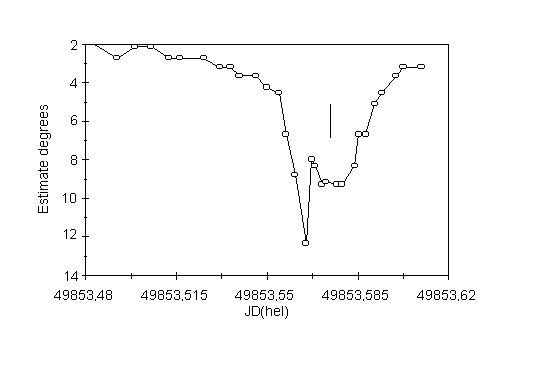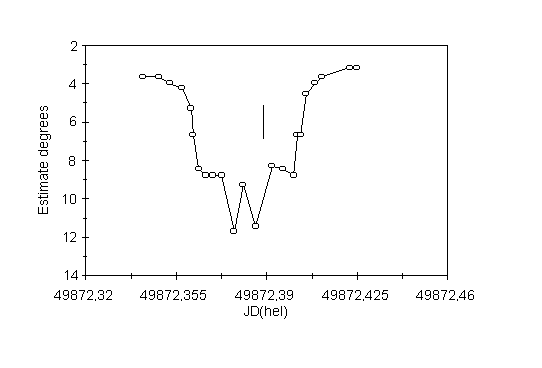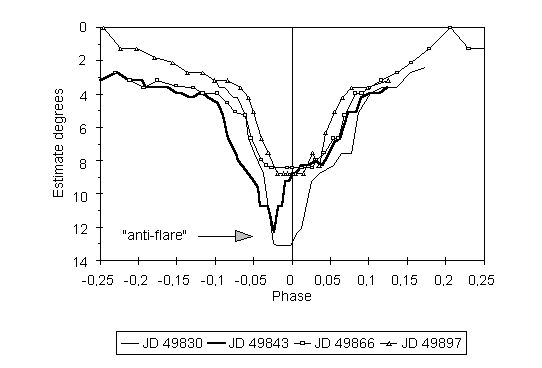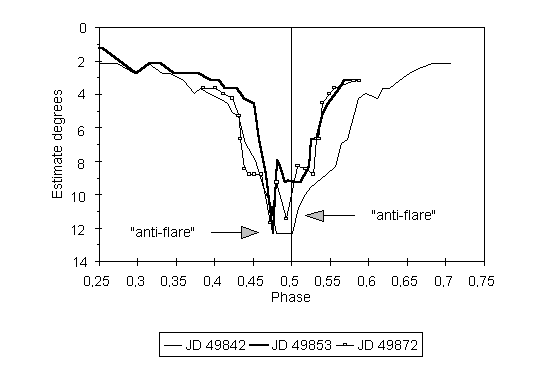
| Go back to Sun Hill Observatory |
SHON - Article
The phenomenon of "anti-flares" in eclipsing binaries of the W UMa-type
Petr Molik
Petrin Hill Observatory, Strahovska 205, 118 46 Prague 1, Czech Republic
Contributed paper. The 29th (International) Conference on Variable Star Research (Brno, Czech Republic, November 7-9, 1997.)
Abstract: The literature on W UMa-stars reports observations of several short-term increases of brightness called "flares". The most famous of these "flare" events was observed in W UMa itself, another "flares" were recorded in U Peg, VW Cep, and in CN And. However, in several other W UMa-stars instead of short-term brightenings there were observed short-term decreases of brightness ("anti-flares"). At least two such events were observed photoelectrically, one in BX And and another in V523 Cas. The author of this communication observed very short-lasting decreases of brightness visually in V839 Oph. Some properties of "anti-flares" suggest their eclipsing nature. Eclipsed areas must be relatively very small and much brighter than remaining parts of the surfaces of given stars and they could be represented by hot spots or by hot surfaces of white dwarfs. This supports the author's hypothesis that at least some of the W UMa-stars are not contact binaries but semi-detached systems in which one component is a white dwarf surrounded by an accretion disk.
As reported in the literature (see e.g. Yang and Liu, 1985), there were observed short-term increases of brightness called "flares" in several binary stars of the W UMa-type. Huruhata (1952) during his photoelectric photometry of U Peg found an unusual brightening near maximum light which lasted about 30 minutes. The increase in brightness amounted to 0.3 mag in U bandpass. But there was no similar flare in V bandpass, so Binnendijk (1960) expressed its doubt about the reality of this phenomenon.
The most famous of these "flare" events was observed twelve years later in W UMa itself by Kuhi (1964). On April 26th, 1964 (JD 24 38 511.681) he registered a rapid increase in brightness lasting only 7 minutes and reaching about 1.5 mag at the wavelength 330nm. It occurred in orbital phase 0.703, i.e. 25 minutes before secondary maximum. Later on, Egge and Petersen (1982) described a "flare" in VW Cep; Yang and Liu (1985) noted a "flare" in CN And. (Distortions in the light curve of 44 i Boo near maximum light which were observed by Eggen (1948) and which are cited in the literature as another example of "flares" in W UMa-stars are certainly not flares.)
However, the aim of this communication is to draw attention to just opposite phenomenon: In several W UMa-stars instead of short-term brightenings there were observed short-term decreases of brightness lasting a few minutes or even less than one minute. These decreases of brightness look like inverse flares or "anti-flares".
At least two events of this kind were observed photoelectrically: Castelaz (1979) during observation of BX And on the night of October 27/28, 1978, registered a very short-lasting (less than one minute) decrease of brightness in orbital phase 0.01. The depth of the decrease was 0.1 mag in V, 0.2 mag in B, and 0.3 mag in U bandpass. Bradstreet (1981) observed similar "sudden dip" in V523 Cas on the night of July 7/8, 1979. The decrease was 0.13 mag deep and occurred in phase 0.6. Neither Castelaz nor Bradstreet gave some explanation of this phenomenon.
The author of this communication observed very short-lasting decreases of brightness visually in V839 Oph. Two examples are presented in Figures 1 and 2 (in these figures thin vertical line between descending and ascending branches mark the theoretical mid-eclipse computed with the use of instant elements valid for given observing season).

Figure 1: The light curve of V839 Oph (secondary minimum) on the night of May 15/16th, 1995 showing an "anti-flare".

Figure 2: The light curve of V839 Oph (secondary minimum) on the night of June 3/4th, 1995 showing two "anti-flares".
The observations were done with the use of 20cm (8 in.) refractor at the Petrin Hill Observatory in Prague (Czech Republic). Focal length of this instrument is 137cm (4.5 ft), magnification 55 times. Visual estimates were done by the method of Nijland-Blazhko using a series of four comparison stars - GSC 1009.1940, GSC 1009.0464, GSC 1009.0237, and GSC 1009.0067 (the third comparison star was added in 1995). The photometric intervals between the comparison stars were not equal so the accuracy of visual estimates decreased with increasing brightness of V839 Oph. The supposed mean error of a single estimate near minimum light is ± 0.03 mag and ± 0.02 mag, while near maximum light it is ± 0.05 mag and ± 0.04 mag for the years 1994 and 1995, respectively.
It has to be said that for a year the author considered these very short-lasting decreases of brightness to be observational errors and only later he get convinced of their reality due to the fact that they had occurred in certain orbital phases. Their duration was less than 10 minutes. Table 1 lists six such events observed in the years 1994 and 1995 that are with high probability real. Note that "anti-flares" No. 1 and No. 6 as well as No. 2 and No. 3 differ exactly by half-period.
Table 1: Very short-lasting decreases of brighthess ("anti-flares") in V839 Oph.
| No. | JD hel | Phase | Approx. value of the decrease |
| 1 | 24 49 548.443 | 0.452 | |
| 2 | 24 49 843.544 | 0.977 | |
| 3 | 24 49 853.565 | 0.477 | |
| 4 | 24 49 872.378 | 0.473 | |
| 5 | 24 49 872.386 | 0.493 | |
| 6 | 24 49 899.568 | 0.952 |
In Figure 3, four light curves of primary minimum of V839 Oph from the interval between JD 24 49 830 - 24 49 897 are superposed on one epoch. It can be seen that the occurrence of an "anti-flare" was preceded by an extremely deep minimum with a flat bottom lasting a quarter of an hour (phases 0.98 - 0.00). The phase when the "anti-flare" was observed coincides with the beginning of the flat bottom. The two remaining curves illustrate normal course of light change during primary eclipse.

Figure 3: A superposition of four light curves of primary minimum of V839 Oph from the interval between JD 24 49 830 - 24 49 897.
In Figure 4, a superposition of three light curves of secondary minimum of V839 Oph from the interval between JD 24 49 842 - 24 49 872 shows almost the same. Again, the occurrence of "anti-flares" was preceded by an extremely deep minimum with a flat bottom lasting a quarter of an hour (phases 0.48 - 0.50). The phase when the "anti-flares" were observed coincides with the beginning of the flat bottom (in the third curve another "anti-flare" was present in the phase corresponding to the center of flat bottom).

Figure 4: A superposition of three light curves of secondary minimum of V839 Oph from the interval between JD 24 49 842 - 24 49 872.
In contrast to "flares" that were recorded in several W UMa-stars in phases around maximum light all "anti-flares" were observed in phases around minimum light. The short-term increases of brightness can be (at least formally) compared to genuine flares but the phenomenon of "anti-flares" is much more puzzling. We do not know any intrinsic physical process that is able to cause such rapid and short-lasting decrease in energy output of stars. So the only plausible explanation of "anti-flares" seems to be eclipses of some parts of binary systems. Because of short duration of "anti-flares" these eclipsed areas must be relatively very small and much brighter than remaining parts of the surfaces of given stars. But even when these bright areas are very small the orbital motion of close binaries composed of main sequence stars is too slow to cause eclipses lasting only one or a few minutes.
Therefore it is necessary to take into consideration that these eclipses can be caused by an object that rotates only around one component star with a speed several times higher than is the speed of orbital motion of given binary system. Such circumstellar (not circumbinary) object can be a transient gaseous stream or permanent accretion disk. But this implies the semi-detached configuration instead of the contact one. The small and bright area which is sometimes eclipsed by a part of the circumstellar object could then be a hot spot or directly the surface of a white dwarf.
Thus the existence of "anti-flares" supports the author's hypothesis that at least some of the W UMa-stars are not contact binaries but semi-detached systems in which one component is a white dwarf surrounded by an accretion disk. For example, if we accept that the above mentioned "anti-flares" in V839 Oph have eclipsing nature (as suggests their occurrence in certain orbital phases) we can assume that they could be caused by additional eclipses of higher latitudes of the degenerated hot primary component (which are normally uneclipsed all over the orbital cycle due to relatively low inclination of orbital plane) with a clump of matter belonging to the accretion disk but orbiting temporarily well above the equatorial plane of the primary component. However, it is only a working hypothesis which can be questioned because it does not explain e.g. why the "anti-flares" occur only near orbital phases 0.0 and 0.5.
For understanding the true nature of "anti-flares" much more observations are needed. The author of this communication would greatly appreciate notifying about any published or unpublished observations of "anti-flares" in W UMa-stars or in other eclipsing binaries.
References:
Binnendijk L., 1960: Astron. J., 65, 88
Bradstreet D.H., 1981: Astron. J., 86, 98
Castelaz M., 1979: Inform. Bull. Var. Stars, No. 1554
Egge K.E., Petersen B.R., 1982, In: Byrne P.B. and Rodono M. (eds), IAU Colloquium 71, "Activity in Red-Dwarf Stars", p. 481
Eggen O.J., 1948: Astrophys. J., 108, 15
Huruhata M., 1952: Publ. Astron. Soc. Pacific, 64, 200
Kuhi L. V., 1964: Publ. Astron. Soc. Pacific, 76, 430
Yang Y.-L., Liu Q.-Y., 1985: Inform. Bull. Var. Stars, No. 2705
SHON - Contents:
| Go top |